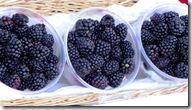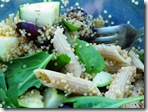Yesterday was important for our world of Nutrition; the USDA released the 2010 Dietary Guidelines! These guidelines are “reviewed, updated if necessary and published every 5 years”. They are not intended for a specific age-group, disease, diet-type or condition. Rather, they are guidelines for everyone “ages 2 years and older.”
Because we all eat the same, right?
Moving on.
There are two simple concepts published to encompass all of the Key Recommendations:
“1) Maintain calorie balance over time to achieve and sustain a healthy weight.
2) Focus on consuming nutrient-dense foods and beverages.”
As most of us know, calories IN have to equal calories OUT for weight management. This may not happen every day, but an overall balance will prevent losing or gaining weight. To some, this is common sense. To some, the second “concept” is part of that balance; something known, but not always practiced. To others, the obesity epidemic in America has reached a point where these needs to be guidelines.
So, there they are.
More specifically, here are the 2010 Key Recommendations
(by category, summarized):
Balancing Calories to Manage Weight
- Prevent overweight/obesity through improved eating & physical activity
- Control total calorie intake to manage body weight (which may mean consume more, less or the same – in/out balance).
- Reduce time spent in sedentary behaviors.
- Maintain appropriate calorie balance during each stage of life (as it will change during childhood, adolescence, adulthood, pregnancy/lactating, and older age).
Foods & Food Components to Reduce (all amounts per day)
- Sodium, to less than 2300 mg (<1500 mg if 51 or older or with specified disease states)
- <10% of calories from Saturated Fat (this hasn’t changed from the previous guidelines)
- Dietary Cholesterol, less than 300mg
- Trans fats: reduce entirely, “by limiting foods that contain synthetic fatty acids” (Look for “Hydrogenated oils” on Ingredient lists)
- Solid fats & added sugars
- Refined grains (i.e. aim for Whole Grains!*)
- Alcohol, consume in moderation (as always)
*In my opinion, a “goal” for America might be reducing the intake of refined grains. A GUIDELINE should be to consume all grains as whole.
Foods & Nutrients to INCREASE (ah, a positive approach!)
- Fruit and Vegetables (we’ll never get away from that one, soak it in!)
- More specifically, a variety of vegetables (dark greens, red/orange vegetables, and peas….but, ahem, if you don’t like peas, that’s okay too).
- Whole Grains – “Consume at least half of all grains as whole”.
Again, go BIG, America! Go for ALL of them. Why not? - Increase intake of Fat-free/Low-fat Milk and milk products or fortified soy beverages. My two cents: Should those be soy/alternative milk options, choose those with at least 20% Daily Value of calcium per serving.
- Variety of protein (take that as you will – clearly lean animal meats are specified in the Guidelines, but as I try to convey here, there are plenty of other options!)
- Variety of seafood (there is an excellent article in the most recent Runner’s World – March, 2011 – with advice on purchasing seafood)
- Oils (e.g. olive, canola) in place of solid fats (e.g.. butter)
All of the above are lessons preached often, but are always worth repeating. A simple fact to keep in mind: none of the above will be fully accomplished by purchasing processed, packaged foods. Easy as that.
*****
You can download and read the Executive Summary of the 2010 Dietary Guidelines here.
There, you will find a general explanation of the guidelines, and more specific statements for certain populations (e.g. pregnancy/breast-feeding, older age, etc).
*****
Discuss!
Will any of the above change the way you eat, or think about food on a daily basis?
Where do you seem room for improvement, upon the next “review”?
What would you add in there?









Very informative, one area I really need to continue to work on is the intake of whole grains over refined, although my store is getting better at adding more whole grain varieties, there are still plenty of things they don’t offer.
Unfortunately I think most people know they should eat better than they do, it’s putting that into practice that is the bigger issue.
You know I love this post! I agree about fruits, vegetables and vegetarian proteins. I very rarely eat refined grains and aim to keep them all whole. Overall, I think people like you are so helpful in educating the masses, but I think it takes a genuine interest (or unfortunately often a health scare!) for people to really care and want to make a change in their diet. Hopefully all of us who are passionate about it can influence and intrigue the people around us. Watch Oprah today with the 1-week Vegan challenge! Should be interesting and informative. xo
I missed Oprah, maybe I can catch it online! You’re very right though, unfortunately it takes a genuine interest and usually a ‘scare’ before people Really stop to think about what they’re eating.
2 comments:
1) Why peas? I found that interesting. With things like broccoli and spinach, why peas?
2) I think there should be a whole section just for children. I realize that this would still be flexible with activity level, specific age, etc, but our kids are what are becoming obese without truely understanding why. And (as a teacher), there must be a program for students to learn specifically about food consumption. Gym is mandated (at least in our state), but their knowledge of food is VERY much lacking. I keep thinking about bringing this into the math that I teach, but time keeps me from changing lessons for now. I really need to fix that.
I agree, there needs to be more information for children, I don’t teach but have 3 children and am surprised by the amount of obese children in their school. There are 2 extremely overweight boys in my oldest class, and both have struggled with their weight since preschool, their parents who are also obese cannot help them, it breaks my heart. One actually got sick last year and was bragging he had lost 5 pounds 😦 it really broke my heart that he honestly thought the only way he can lose weight was to be sick.
Ha, I’m not sure why they singled out Peas. I found that a little odd, too. And I completely agree, childrens’ nutrition requirements are so important and often glossed over.
Thanks for the great recap of some very important news. My favorite part of the new guidelines: The suggestion to fill half your plate with veggies. Too often, vague nutritional recommendations make me think of failed New Year’s Resolutions (i.e., “lose weight” as opposed to “go to the gym for one hour five times a week to lose X poinds”)—this is so concrete, and so easy to apply to every meal!
I think they need to educate more people on the good fats, even good saturated fats like coconut. Sugars need to be controlled and sodium. Those go hand in hand in my opinion. Thanks for sharing this!
Fascinating! I love how specific these recommendations are, but I have a decent amount of nutrition knowledge (notice I did not say “a Lot” 🙂 ). I wonder if there are more ways to educate? Some people probably don’t know what “refined grains” look like at Kroger.
Kate and Lindsay – both spot on! Education is key, these guidelines could mean nothing without the right amount of a “base knowledge”.
Pingback: America’s 2010 Dietary Guidelines | CookingPlanet
Thanks for spreading the word! At this point, most of it is pretty “common sense” to me, but I know that’s not the case for everyone. And it never hurts to be reminded.
The Canada Food Guide has similar principles and also suggests X number of servings from the variosu food groups, depending on age/gender/etc.
We just spent almost an hour in class talking about these. I liked how they’re pushing fruits & veggies, but I think they should explain things better to the public, who don’t understand nutritional talk. Education is a big problem because most people do not know serving sizes or what a whole grain is and stuff like that.
i wrote about the new guidelines today, too! i have a lot of thoughts about them, but one thing that i noticed that was new this year was that they had both vegan and vegetarian dietary patterns in the appendices – a nice change in my opinion! 🙂
Agreed!!
Pingback: food for thought: some perspectives on the Oprah vegan show « She said. She said.